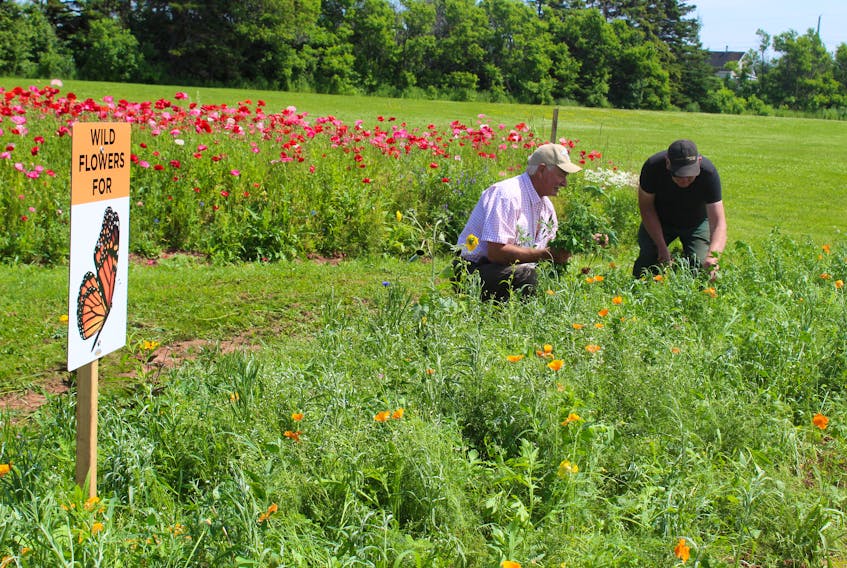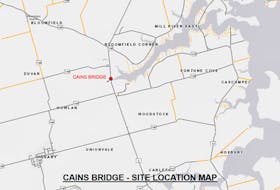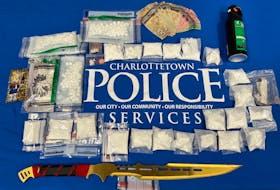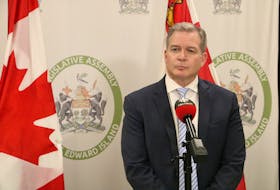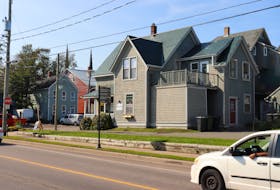BEDEQUE, P.E.I. — As Ron Rayner and Garth Harper laboured under Monday’s hot sun to pull weed after weed from the former’s new pollinator garden, a truck with Nova Scotia plates pulled over on the road above them.
Hella Barwise clambered out of the vehicle and down the small embankment onto Rayner’s lawn.
“This is just beautiful,” she said before adding, “we don’t have enough bees."
Rayner has an expansive front lawn on his Bedeque property and routinely uses parts of it to grow things that strike his interest, towering sunflowers especially.
But a couple of years ago he decided he wanted to do more for local pollinators, like bees and started tilling up a handful of large patches of earth near his property’s border with Route 1A.
“I love it,” he said.
“I’ve got the time, I’ve got the energy, I’ve got every piece of equipment you could want to do this,” he said.
He spent about $300 on wildflower mixes from P.E.I.’s Vessey’s Seeds, one tailored to bees, and one for birds and butterflies.
The bee mix went in the ground last year and is currently producing a sea of red and pink poppy flowers.
The other two beds were only seeded this year with the bird/butterfly mix and are still growing, though both have plenty of squat orange and yellow flowers blooming right now.
There were no butterflies on hand Monday but a good number of bees were making liberal use of the buffet.

The butterfly and pollinator garden movement has been growing around the world for years now. The idea is to give nature’s workhorses, bees, birds, moths, bats, butterflies and other pollinators a helping hand by growing plants with them in mind.
The Bedeque Bay Environmental Management Association (BBEMA) has been at the forefront of this movement locally for several years.
That group’s executive director, Tracy Brown, was happy to hear about Rayner’s gardens. They regularly get people reaching out, looking for more information about how to help pollinators, she said, and it’s always nice to see people getting involved. For more information about BBEMA’s pollinator and monarch butterfly programs, check out their website https://bbema.ca/.
But Brown also encouraged caution for any potential green thumb who buys “wildflower mixes,” to help pollinators.
Some of these mixes have been shown to include potentially problematic species that, if left unchecked by inexperienced gardeners, can spread quickly and become invasive.
“Just see what species are in there before you dump them. Because you could have your neighbour be cranky with you in about two years,” said Brown.
John Barrett, media representative with Vessey’s, said the company has horticulturalists on staff who can answer questions from the public if they have those types of concerns.
Rayner did his research before planting his pollinator garden. The poppies flowers that currently make his beds so colourful can spread like crazy, so they have an upcoming date with a scythe to prevent most of them from setting seeds. He still expects many to grow back next year but they will be in manageable numbers.
Rayner expects all beds to change significantly as the various species mature and die back over the course of the summer and fall.
Just so there’s no confusion about what the flowers represent, he’s installed three bright signs, provided at a discount by Sign Station, explaining what the garden is for.
Since the signs went up, people have been pulling over to take a look or snap pictures, which Rayner doesn’t mind people doing at all.
“I love my property,” he said, smiling as he went right back to weeding.
Buzzing about colours
Want to attract pollinators to your garden? Keep an eye on what colours you’re planting.
- Bees are more attracted to blue and violets and like cup-shaped flowers they can crawl inside of.
- Hummingbirds are attracted to pinks, reds and fuchsias and like bees prefer cupped flowers.
- Butterflies are more attracted to yellows and oranges and enjoy flat flowers that are easy to settle their weight on. Monarchs especially require swamp milkweed as part of their diet.
- Night pollinators like lunar moths and bats are attracted to whites and pale-yellow flowers.
- If you’re looking to find a happy medium that will attract some of all these species, focus on red and purple flowers.

